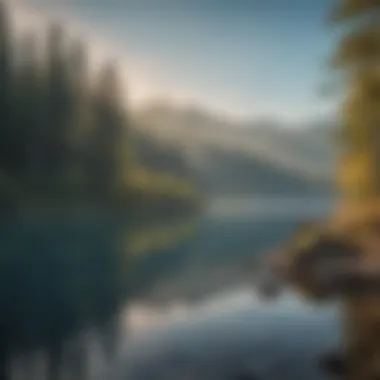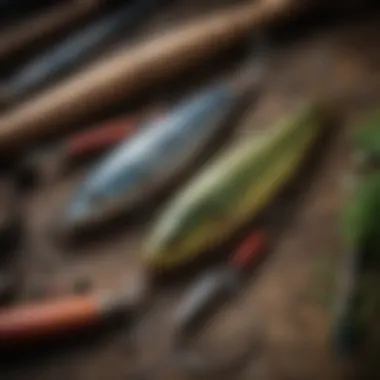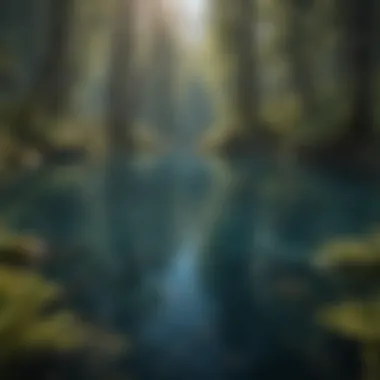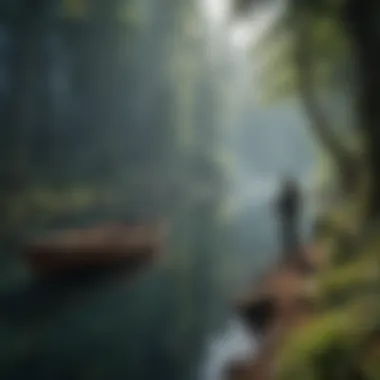Exploring Blue Lake Fishing: Techniques and Ecology


Intro
Blue Lake fishing presents a unique intersection of recreational activity and ecological sustainability. This niche of fishing is deeply embedded within the context of environmental health and the vitality of aquatic ecosystems. Understanding the intricate networks within blue lakes is essential for both enthusiasts and professionals engaged in this activity. In this article, we will dissect various aspects of blue lake fishing, ranging from effective methods to ecological considerations, ensuring that insights offered are grounded in research and empirical knowledge.
Understanding Blue Lake Ecosystems
Blue lakes are often distinguished by their pristine waters and rich biodiversity. These ecosystems are not only beautiful but are crucial for numerous species that rely on them for survival.
Importance of Biodiversity in Blue Lakes
Biodiversity within blue lakes encompasses a range of organisms, from plankton to larger species such as fish and amphibians. A rich variety of life forms contributes to the ecological balance, ensuring resilience against environmental changes. Biodiversity acts as a buffer, protecting the lake's ecosystem from factors such as pollution and climate change.
Role of Blue Lakes in Climate Regulation
Blue lakes play a significant role in climate moderation. They can absorb carbon dioxide and help in regulating temperature within their surrounding environments. This equilibrium contributes not only to their health but also to the well-being of adjacent terrestrial ecosystems.
"Healthy lakes serve as vital regulators in local climates, acting as natural reservoirs for carbon storage."
Sustainable Fishing Practices in Blue Lakes
Sustainability in fishing encompasses practices that ensure the longevity of fish populations and the overall integrity of the lake environment.
Principles of Sustainable Fishing
To engage in sustainable fishing, one must adhere to certain principles:
- Catch limits: Adhering to regulations around how many fish can be captured helps preserve fish populations.
- Selective fishing: Targeting specific species and minimizing bycatch helps maintain biodiversity.
- Seasonal restrictions: Fishing during designated times allows fish populations to reproduce and regenerate.
Case Studies of Sustainable Practices
Examining various regions that have implemented sustainable fishing highlights its effectiveness. For instance, certain communities around the Great Lakes have adopted catch and release strategies, demonstrating a commitment to environmental stewardship while still enjoying the sport.
Key Techniques for Blue Lake Fishing
Successful fishing in blue lakes requires understanding specific techniques tailored to these unique environments.
Effective Techniques
- Float Fishing: This method is beneficial for keeping bait at varying depths, mimicking the natural feeding patterns of fish.
- Bottom Fishing: Ideal for lake bottoms where fish are likely to gather, this technique allows for targeting species that tend to dwell near the substrate.
Equipment Required
Selecting the right equipment can enhance the fishing experience:
- Rods and Reels: Choose rods that provide sufficient flexibility. Consider spinning reels for ease of use.
- Bait Selection: Use live bait such as worms or artificial lures that resemble the natural food sources present in the lake.
Closure


As we delve into blue lake fishing, it is imperative to recognize the ecological context that underpins this activity. Responsible fishing practices not only contribute to our enjoyment but also ensure that these ecosystems remain vibrant for future generations. By marrying recreational interests with sustainable practices, we can cherish and protect the beauty of blue lakes.
Preface to Blue Lake Fishing
Understanding blue lake fishing is essential for anyone interested in the ecological and recreational aspects of this activity. The importance of exploring this topic lies in its multifaceted nature, as it encompasses not only the techniques of fishing but also the vibrant ecosystems that support diverse aquatic life. This article addresses the significant roles these lakes play in biodiversity and the responsibilities of anglers to preserve these precious environments.
Definition and Overview
Blue lakes are typically characterized by their clear water and unique formations. They often exist in mountainous or volcanic regions, where geographic features contribute to their distinct ecosystem. These lakes host a variety of fish species, making them attractive sites for fishing enthusiasts. The definition of blue lake fishing revolves around the practice of angling in these specific freshwater bodies. This dedication to fishing in blue lakes reflects a broader interest in sustainable practices. With a rise in the appreciation for nature, enthusiasts are drawn to these ecosystems not just for recreational purposes but also for their ecological significance.
Importance of Blue Lake Ecosystems
The ecological value of blue lakes cannot be overstated. They serve as habitats for many fish species, including trout and bass, which rely on the unique water quality and temperature provided by these environments. The blue hue of these lakes indicates high levels of dissolved oxygen, which is crucial for aquatic life.
Moreover, blue lake ecosystems contribute to water quality enhancement in broader regions. Plants in and around these lakes help filter pollutants and improve oxygen levels, which benefits both wildlife and humans. Understanding the interconnectedness of these ecosystems is vital for fostering sustainable fishing practices.
The balance of life in blue lakes is delicate. Preservation of these ecosystems is critical for future generations.
In summary, the introduction to blue lake fishing is not just about the act of fishing itself; it encompasses the importance of respecting and understanding the ecosystems that form the backdrop for this recreational activity. Engaging with these habitats requires knowledge and appreciation, as blue lakes offer rich biodiversity and serve as essential resources for both nature and society.
Ecological Characteristics of Blue Lakes
Understanding the ecological characteristics of blue lakes is crucial for recognizing the interplay between aquatic and terrestrial environments. Blue lakes often serve as vital resources in local ecosystems, supporting a diverse array of life and providing essential functions like water filtration and habitat conservation. A thorough analysis of these lakes can enlighten fishermen, conservationists, and policymakers about the balance of nature that sustains fish populations and biodiversity. This section will examine key elements that define the health and sustainability of these ecosystems.
Water Quality and Biodiversity
Water quality is a fundamental aspect of blue lakes, serving as a determinant for the organisms they support. Factors such as pH levels, temperature, and nutrient concentrations profoundly affect aquatic life. Clean, well-oxygenated water tends to support a wider range of species, fostering diverse communities within these ecosystems.
Benefits of Healthy Water Quality:
- Supports Fish Populations: High water quality ensures that fish have adequate oxygen levels and less competition from harmful algae blooms.
- Encourages Biodiversity: A well-balanced ecosystem can host various species, from microscopic plankton to larger fish and aquatic plants.
Biodiversity in blue lakes is reflected in the number of species present and their interactions within the environment. Increased biodiversity contributes to ecosystem stability, resilience, and productivity. Protecting and maintaining water quality can enhance biodiversity, creating a positive feedback loop.
"Maintaining water quality not only supports aquatic life but also enhances the entire ecosystem, promoting sustainable fishing practices."
Common Fish Species Found
Blue lakes are often home to a variety of fish species, each adapted to their specific environments. The presence of certain species can indicate the overall health of the ecosystem. Some common fish found in blue lakes include:
- Trout: Known for their preference for cooler waters, trout thrive in well-oxygenated lakes. They are indicators of good water quality.
- Bass: Various species of bass are commonly found in blue lakes, often at the top of the food chain, affecting the population dynamics of other fish.
- Panfish: Bluegills and crappies are example of panfish prevalent in many blue lakes, popular for fishing.
- Pike: This predatory fish often inhabits the water's edges, contributing to the biological balance.
Assessing the fish population in blue lakes provides insights into the ecological health of these environments. Monitoring species diversity and population sizes is critical for implementing effective conservation strategies and ensuring sustainable fishing practices.
Techniques for Successful Blue Lake Fishing
Fishing in blue lakes offers a unique experience that combines art and science. Understanding the techniques needed for success not only enhances the likelihood of catching fish but also promotes responsible engagement with the aquatic environment. The right methods increase effectiveness, respect for wildlife, and ultimately ensure the sustainability of blue lake ecosystems.
Essential Fishing Gear


Having the appropriate gear is fundamental for easy and successful fishing in blue lakes. Here are some key items to consider:
- Fishing Rod: A medium-action rod is often preferred due to its versatility in various fishing conditions. Lengths between 6 to 7 feet work well for casting.
- Reel: A spinning reel is user-friendly, making it a popular choice. Look for one that balances well with your rod.
- Line: Select a monofilament line with a test strength suited for the types of fish you are targeting.
- Bait and Lures: Live bait like worms or minnows can be effective, but lures such as spinners or jigs also attract fish.
- Tackle Box: Organize your gear with a tackle box containing hooks, weights, bobbers, and other essentials.
Casting Techniques
Casting skill significantly influences fishing success. Here are techniques to improve your casting:
- Overhead Cast: This is the most common technique. Hold the rod above your head and swing it downwards while releasing the line.
- Sidearm Cast: Use this cast when fishing in dense areas like trees. It allows for a lower, more controlled throw.
- Roll Cast: Ideal for limited space, this technique involves rolling the line forward without backcasting.
Practicing these casts can help you place your bait accurately where fish are likely to be.
Timing and Weather Considerations
Fishing success in blue lakes also relies on timing and weather conditions. Here are some important points:
- Time of Day: Early morning and late evening are often the most active times for fish as they feed.
- Seasonal Variations: Understanding the seasonal behavior of fish helps in planning your trips. For instance, late spring and early fall can yield good results.
- Weather Patterns: Fish tend to be more active before a storm and less so during extremes of weather. Slightly overcast days are often considered prime fishing time.
The Role of Sustainable Practices in Blue Lake Fishing
Sustainable practices in blue lake fishing play a crucial role in preserving aquatic ecosystems. As fishing continues to be a popular activity, understanding how to engage responsibly becomes paramount. As a community of anglers, recognizing our impact and implementing sustainable methods can ensure that blue lakes remain vibrant habitats for future generations.
Impact of Overfishing
Overfishing poses significant threats to fish populations and the overall health of blue lake ecosystems. When fish are extracted faster than they can reproduce, it leads to dwindling populations. This not only affects the primary species sought by fishermen but also disrupts the food chain. For example, species like trout and bass depend on a balanced ecosystem to thrive.
- Ecosystem Imbalance: A reduction in one species can lead to overpopulation of others, creating further instability.
- Local Economies: Communities that rely on fishing for their livelihoods can be severely influenced if fish populations collapse.
- Long-term Viability: By allowing fish stocks to recover through regulated catch limits, the fishery can maintain its productivity.
Conservation Efforts
Addressing the issues of overfishing requires collective conservation efforts. Organizations and local authorities are establishing regulations to manage fish populations effectively. Some of these include:
- Catch and Release Programs: Encouraging anglers to return fish to the water.
- Habitat Restoration: Initiatives to rebuild breeding grounds and improve water quality.
- Education and Awareness: Workshops and materials to inform fishermen about sustainable practices.
Furthermore, partnerships between conservation groups and fishing organizations are vital. These collaborations ensure that knowledge is shared and that policies are implemented based on the latest research. A strong community approach can enhance the effectiveness of these efforts.
Best Practices for Fishermen
To promote sustainability, anglers can adopt various best practices in their fishing routines:
- Follow Local Regulations: Adhering to guidelines provided by local wildlife agencies ensures that fishing practices align with conservation goals.
- Use Environmentally Friendly Gear: Selecting tackle and bait that minimize ecological impact can help preserve habitats.
- Practice Responsible Catching: Limiting catch sizes and choosing to fish for species that are abundant can help maintain populations.
- Participate in Local Cleanups: Engaging in efforts to clean lakes not only improves the environment but also builds community among anglers.
By integrating these practices, fishermen contribute to sustainable blue lake fishing, ensuring that this activity can be enjoyed while protecting vital aquatic resources.
"Sustainability in fishing is not just a trend; it's a necessity for preserving the ecosystems we cherish."
Adopting sustainable fishing practices is essential in ensuring that blue lakes can be enjoyed by future generations. As custodians of these ecosystems, the fishing community holds the responsibility to engage in actions that reflect a commitment to environmental stewardship.
Regional Variances in Blue Lake Fishing


Understanding the regional variances in blue lake fishing is essential for grasping the broader impact of this practice on local communities and ecosystems. Each region offers unique fishing conditions, regulations, and cultural practices that influence the fishing experience. Fishermen and nature enthusiasts must adapt their techniques to suit local environments, making this knowledge a critical part of responsible fishing.
Different geographical locations bring distinct species to the forefront. For example, Blue Lake in New Zealand is known for its crystal-clear waters and a wide variety of trout, while the blue lakes in the Rockies of the U.S. offer opportunities to catch species like cutthroat trout. The ecology of these lakes directly affects the availability and health of fish populations, which in turn shapes fishing practices. This section aims to delve into specific blue lakes around the world and discuss their unique characteristics, as well as the cultural significance of fishing in various regions.
Notable Blue Lakes Around the World
- Blue Lake, New Zealand
Famous for its stunning clarity, this lake hosts various trout species. Its unique ecosystem is both fragile and rich, attracting anglers year-round. - Lake Louise, Canada
Nestled within Banff National Park, Lake Louise features breathtaking scenery and a range of trout. The pristine nature here emphasizes the need for sustainable fishing practices. - Crater Lake, USA
This unique lake was formed in a caldera, leading to a distinctive ecosystem. Though fishing is limited here, it is renowned for its deep blue hue and crystal-clear waters, home to rare species. - Lake Biwa, Japan
As the largest freshwater lake in Japan, Lake Biwa supports diverse aquatic life and fishing culture. The unique species found here play a vital role in local traditions.
These notable blue lakes serve as prime examples of how specific conditions can shape fishing experiences and regulations. Each lake not only offers a unique ecological system but also has cultural significance linked to its usage.
Cultural Significance of Fishing in Different Regions
Fishing is deeply ingrained in many cultures. In some places, it represents a way of life, while in others, it is a recreational pursuit. The cultural frameworks surrounding fishing often dictate how it is perceived and practiced.
- Indigenous Practices: In many regions, indigenous communities rely on fishing for sustenance. They fish not only for food but also as a part of their traditions, passing down skills through generations. Environmental stewardship is often a key aspect of these practices.
- Tourism and Economy: In areas popular for blue lake fishing, such as the lakes in the Rocky Mountains, fishing contributes significantly to local economies. Many towns flourish due to tourism related to fishing activities.
- Regulations and Conservation Efforts: Local customs and regulations often evolve in response to fishing pressure. This can lead to stricter conservation measures, affecting how fishing is approached in each region. Understanding these nuances helps promote responsible and sustainable practices among fishermen.
Fishing, therefore, becomes not just an activity but a lens through which we can view the social, economic, and environmental health of a region.
Resources for Blue Lake Fishing Enthusiasts
The resources for blue lake fishing enthusiasts play a critical role in enhancing the fishing experience. These resources provide valuable information on techniques, conservation methods, and community engagement. By utilizing various materials, anglers can become better informed and more responsible participants in this activity. The sections that follow aim to serve a wide range of interests, from novices to seasoned professionals, ensuring everyone has access to essential insights and practical guidance.
Books and Guides
Books and guides are paramount for anyone serious about blue lake fishing. They offer both foundational knowledge and advanced techniques. Texts that focus on specific localities or species can guide prospective fishers in understanding the unique aspects of their chosen area. Publications that include illustrations can also greatly assist in identifying fish species and habitat characteristics.
For example, Field guides like Freshwater Fish of North America provide detailed entries on various species, habitat requirements, and fishing methods. They often include photographs to help with identification. Similarly, instructional books can enhance one’s skills with proven strategies and tips regarding fishing gear and tactics.
Online Communities and Forums
Engaging with online communities can significantly enrich the experience of blue lake fishing. Websites like Reddit have dedicated forums where enthusiasts share experiences, tips, and advice. These platforms create an interactive space for both beginners and experts. Users can post questions about specific challenges they face or share successful techniques that worked for them.
Moreover, discussing with peers helps develop a collective knowledge base. Engaging in these forums enhances the understanding of local regulations, seasonal changes in fish behavior, and effective gear choices. It is important to approach discussions with an open mind, as varied perspectives provide deeper insights into fishing practices.
Local Workshops and Events
Participating in local workshops and events is another valuable resource for blue lake fishing enthusiasts. Many fisheries and community organizations host educational seminars. These events often cover everything from sustainable practices to advanced fishing techniques. Hands-on workshops can also allow anglers to practice their skills in a guided environment, giving them the chance to receive direct feedback from experts.
Moreover, events create networking opportunities. They help build relationships with other fishing enthusiasts, conservationists, and local business owners. By attending these gatherings, participants can stay informed on the latest trends and regulations affecting blue lake fishing, ensuring they are well-prepared for their next outing.
In summary, leveraging books, online communities, and local workshops can profoundly enhance the knowledge and skills of anyone interested in blue lake fishing.
Ending
The conclusion serves as a critical synthesis of the extensive discussions presented throughout the article. It offers a summation of the essential points regarding blue lake fishing, highlighting the interplay between ecological considerations and practical fishing techniques. Understanding these elements enriches not only the expertise of enthusiasts but also elevates the experience of engaging with these exquisite ecosystems.
Summary of Key Takeaways
- Ecological Significance: Blue lakes boast unique ecosystems that support a rich variety of plant and animal life. These ecosystems are essential for maintaining biodiversity, which directly influences fishing quality.
- Sustainable Practices: The article emphasizes the importance of conservation efforts. Sustainable fishing methods help mitigate the impact of overfishing and ensure the health of the aquatic environment for future generations.
- Diverse Techniques: Various fishing techniques are requisite for successful blue lake fishing. From selecting appropriate gear to utilizing effective casting methods, understanding the nuances can make a substantial difference in outcomes.
- Resource Utilization: A range of resources exists for those keen on improving their fishing skills or engaging responsibly with blue lakes. From literature to online communities, these can provide valuable insights and camaraderie among anglers.
- Regional Awareness: The cultural significance of blue lake fishing may vary across different regions, influencing local practices and traditions. Acknowledging these variances adds a richer layer to the fishing experience.
Final Thoughts on the Future of Blue Lake Fishing
The future of blue lake fishing hinges on increased awareness of sustainable practices and ecological stewardship. As more anglers and industry professionals prioritize the health of aquatic ecosystems, the possibilities for maintaining the vibrant biodiversity of blue lakes expand. Education plays a vital role in this shift. Key stakeholders must encourage responsible fishing habits that respect the intricate balance within blue lakes.
Ultimately, the continuation of blue lake fishing as a gratifying and enriching activity lies in our collective effort to safeguard these environments. Engaging in responsible habits not only enhances personal experiences but also contributes to the longevity and health of the ecosystems we cherish. In doing so, we ensure that future generations may enjoy the splendor of blue lakes and the satisfaction of fishing therein.







